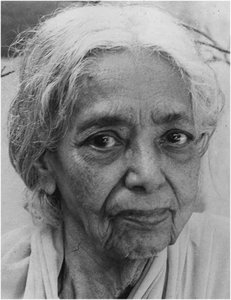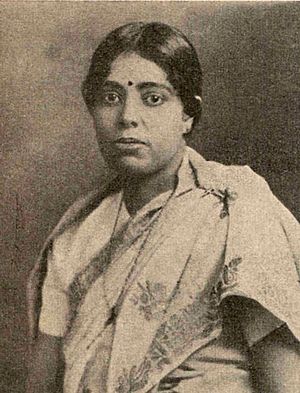Janaki Ammal facts for kids
Quick facts for kids
Janaki Ammal
|
|
|---|---|
 |
|
| Born | 4 November 1897 Tellicherry, Madras Presidency, British India
|
| Died | 7 February 1984 (aged 86) Madras, Tamil Nadu
|
| Nationality | Indian |
| Alma mater | University of Michigan |
| Awards | Padma Shri 1977 |
| Scientific career | |
| Fields | Botany, Cytology |
| Institutions | Madras University, John Innes Centre |
| Thesis | Chromosome Studies in Nicandra physaloides |
| Signature | |
Janaki Ammal Edavalath Kakkat (born November 4, 1897 – died February 7, 1984) was an amazing Indian botanist. She studied plants and how they grow and change. Her work focused on plant breeding, which is like helping plants have better babies. She also studied the tiny parts of plant cells (cytogenetics) and where different plants grow around the world (phytogeography).
Janaki Ammal is famous for her work on sugarcane and the eggplant (also called brinjal). She helped create new types of these plants. She also wrote a book called Chromosome Atlas of Cultivated Plants in 1945 with C.D. Darlington. She was very interested in plants used for medicine or for making money, especially those from the rainforests of Kerala, India. In 1977, the Indian government honored her with the Padma Shri award.
Contents
Her Life Story
E.K. Janaki was born in Thalassery, Kerala, India. Her father was Edavalath Kakkat Krishnan, a sub-judge, and her mother was Devi Kuruvayi.
Janaki went to school at Sacred Heart Convent in Thalassery. Then she studied at Queen Mary's College in Madras. She earned a special degree in Botany from Presidency College. In 1924, she traveled to the United States to study at the University of Michigan. She received her master's degree in botany in 1926 with a special scholarship.
After her master's, she came back to India. She worked as a professor at the Women's Christian College in Madras. Later, she returned to the University of Michigan. She earned her PhD in 1931. Her PhD paper was about "Chromosome Studies in Nicandra Physaloides." The University of Michigan also gave her an honorary law degree in 1956.
When she returned to India again, she became a Professor of Botany. She taught at the Maharaja’s College of Science in Trivandrum from 1932 to 1934. After that, Janaki joined the John Innes Institute in London, England. There, she worked with C.D. Darlington, who became a long-time partner in her research.
She then worked at the Sugarcane Breeding Institute in Coimbatore, India. She helped create new types of sugarcane, including a special variety called SG 63-32.
In 1939, Janaki went to a big science meeting in Edinburgh, Scotland. Because World War II started, she had to stay in England. She spent the next six years at the John Innes Centre. She worked as an assistant cytologist, studying plant cells with C.D. Darlington. Together, they published the Chromosome Atlas of Cultivated Plants in 1945.
From 1945 to 1951, she worked at the Royal Horticultural Society in Wisley, England. She studied beautiful Magnolia flowers, looking at their cells and trying to create new types by mixing them.
The Indian government asked her to help organize the Botanical Survey of India. She became the first director of the Central Botanical Laboratory in Prayagraj. Later, from 1962, she worked in Jammu. She also worked for a short time at the Bhabha Atomic Research Centre. In 1970, she settled in Madras. She continued her research as an Emeritus Scientist at the University of Madras. She lived and worked in the university's field laboratory until she passed away in February 1984.
Her Plant Research
Janaki was an expert in cytogenetics, which is the study of chromosomes in cells. She joined the Sugarcane Breeding Station in Coimbatore to study sugarcane. At that time, India imported the sweetest sugarcane from Papua New Guinea. The Sugarcane Breeding Station was set up to make India's own sugarcane better.
Janaki used her skills to create a new type of sugarcane. This new sugarcane grew very well in India. She did this by carefully mixing different sugarcane types in the lab. Her research also showed where sugarcane grew naturally across India. She found that a type of sugarcane called Saccharum Spontaneum first came from India.
Janaki faced some challenges in her work. But her amazing research caught the eye of the Royal Horticultural Society in England. They invited her to work at their famous gardens near Kew.
While in England, Janaki studied the chromosomes of many different garden plants. Her studies helped scientists understand how plant species change over time. The book The Chromosome Atlas of Cultivated Plants, which she wrote with C. D. Darlington, included much of her own work.
One plant she worked on was the magnolia. Even today, there are magnolia trees she planted at the Society's garden in Wisley. There is even a type of magnolia with small white flowers named after her: Magnolia kobus 'Janaki Ammal'.
Janaki also studied other plants like Solanum (which includes potatoes and tomatoes), Datura, Mentha (mint), and Dioscorea (yams). She believed that the cold, wet Himalayas in northeast India had more plant types than the dry northwest Himalayas. This was because of how plant cells multiplied there. She also thought that plants from China and Malaysia mixing with Indian plants helped create even more new plant types in northeast India.
After she retired, Janaki kept publishing her research. She focused on medicinal plants and ethnobotany, which is the study of how people use plants. She even created a garden of medicinal plants at the Madras University Field Laboratory where she lived.
In the 1950s, Janaki studied how a chemical called colchicine affected plants. She used it on young magnolia plants. This chemical made the plant cells have twice the usual number of chromosomes. The plants that grew from this had thicker leaves and flowers that lasted longer. She planted many of these special magnolia seedlings at Wisley.
Awards and Honors
Janaki Ammal is remembered as one of the most important Indian Americans of the 20th century. She was likely the first Indian woman to get a PhD in botany in the U.S. in 1931. She is also one of the few Asian women to receive an honorary Doctor of Science degree from her university, the University of Michigan.
She became a Fellow of the Indian Academy of Sciences in 1935. In 1957, she became a Fellow of the Indian National Science Academy. The University of Michigan honored her in 1956 for her work in botany. They said she was a model for all scientists because of her careful and dedicated work.
In 1977, the Government of India gave her the Padma Shri award. In 2000, the Indian government created the National Award of Taxonomy in her name.
She also created many new types of brinjal (eggplant).
Two awards were created in her name in 1999: the E.K. Janaki Ammal National Award on Plant Taxonomy and the E.K. Janaki Ammal National Award on Animal Taxonomy. There is a plant collection (herbarium) with over 25,000 plant types in Jammutawi named after her. The John Innes Centre also offers a scholarship for PhD students from developing countries in her name.
Plants and Animals Named After Her
To honor her work, the Royal Horticultural Society in England named a type of magnolia she created Magnolia Kobus 'Janaki Ammal'. In 2018, two rose breeders named a new rose variety E.K. Janaki Ammal to celebrate her.
A plant called Janakia arayalpathra is also named after her.
Sonerila janakiana, a plant in the Melastomataceae family, is named after her.
Dravidogecko janakiae, a type of gecko lizard found in India, is also named after her.
See also
 In Spanish: Edavalath Kakkath Janaki Ammal para niños
In Spanish: Edavalath Kakkath Janaki Ammal para niños


